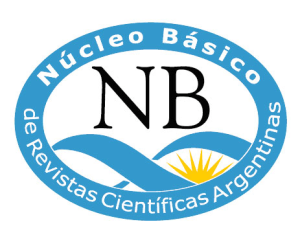The "Immaculate Conception" Chapel and the network of power in Bariloche during the first decades of the 20th century
Keywords:
Patagonia, Bariloche, Chapel, Salesians, TerritoryAbstract
This work is about the formation of the first Catholic group around the construction of the chapel "Inmaculada Concepción" in Bariloche (1907), as a space for the visibility of economic power and social prestige. The founding commissions of the chapel were formed by members of the company Chile Argentina, representing neighbors of the incipient urban population of San Carlos and missionaries of the Salesian Congregation coming from the mission founded in Junín de los Andes in 1892. The chapel is the symbol of the Catholic origins of the town linked to the urban elite that operated as the identity matrix of the city, distributing power and creating territoriality. The religious territory superimposes power constructions that expand and cross it through scales that function as constructions and expressions of social processes. This proposal is framed in studies that combine religion, power and territory and aims to analyze the spatialization of space this singular space as a communal process through two agencies that build power: the Salesians and the pro-temple commission for the construction of the chapel conformed by the "characterized neighbors". We propose for the analysis of written documentary sources, conceptualizations coming from the critical geography about the process of territorialization and specifically about the geography of religion, which are complemented with categories of social processes in the conformation of agencies in the territory. In the first place, we will give an account of the creation of a Catholic territory in a binational space through the territorialization of the Salesian agency and the social, political and economic conformation of the incipient town of Bariloche. In the second section, we will focus on the chapel "Immaculate Conception", through the framework of power agencies in the territory: the territorial State, its representatives and law enforcement, the Catholic Church and the Salesian Congregation, the Pro Temple commissions and the company Chile Argentina to which the majority of its members belonged.Downloads
References
Archivio Salesiano Centrale, F066, Visita straordinaria Pietro Ricaldone. 1909. ASC.
Archivo Salesiano Patagónico. Crónicas de la Casa San Carlos de Bariloche 1906-1907,1915-1926. Memorias del P. Zacarías Genghini y Crónicas de la Casa de Junín de los Andes, 1908-1916. APS
Archivo Propaganda Fide, NS, vol. 581. Doc. 245. Carta del Señor Don A. Nichell. Compañía Inglesa. Pilcaniyeu- Rio Negro al Colegio Propaganda Fide, Bariloche, 16 de junio de 1913.APF
Argeri, María. “La peor plaga que pudo haber traído la locomotora. Prostitución y control estatal en un Territorio Nacional Norpatagónico: Río Negro 1880-1920”. Anuario de Estudios Americanos: 1999, 56,1:.217-235.
Benedetti, Alejandro. “Territorio: Concepto integrador de la geografía contemporánea”. En Souto, P (coord.) Territorio, lugar, paisaje: prácticas y conceptos básicos en Geografía. Buenos Aires: Filosofía y Letras/UBA. 2011. pp.8-82.
Bosco, Giovanni y Barberis, Giulio. La Patagonia e le Terre Australi del Continente Americano” (1876). Roma: LAS [1876] 1988.
Brace, C, Bailey, A y Harvey, D. “Religion, place and space: a framework from investigating historical geographies of religions identities and communities”. Progress of Human Geographies, 30, 2006, 28-43.
Biedma, Juan. Crónica histórica del lago Nahuel Huapi. Buenos Aires: Del Nuevo Extremo y Caleuche. 2003.
Brow, J. “Notes on Community, Hegemony and Uses of the Past”. Anthropological Quartely: 1990, 63 (I): 1-6.
Carballo, Cristina. “Repensar el territorio de la expresión religiosa”. Cristina Carballo, Cultura, territorios y prácticas religiosas. Buenos Aires: Prometeo, 2009.
Cintra, José Thiago. Seguridad Nacional, poder nacional y desarrollo. México. CISEN.1991.
Diario Río Negro, 7 de junio de 1934.
Diario La Prensa, 5 de julio de 1916.
Dizionario biográfico degli italiani al Plata. Buenos Aires: Argos, 1899.
Fogelman, Patricia, Ceva, Mariela y Touris Claudia (Ed.) El culto mariano en Luján y San Nicolás. Religiosidad e historia regional. Buenos Aires, Biblos. 2013.
Juárez, Francisco. "Pasión y agonía de un poderoso comisario”. Diario Río Negro [General Roca]. 8 jul. 2001.
Laurín, Alicia. “Revisiones conceptuales asociadas a la nueva territorialidad de la integración”. Navarro Floria, Pedro y Delrio, Walter (comp.) Cultura y Espacio. Araucanía Norpatagonia. Tomo I. Bariloche. Universidad Nacional de Río Negro / IIDyPCa. 2011. 15-27.
Magnaghi, Alberto. “Una metodologia analitica per la progettazione identitaria del territorio”. Alberto Magnaghi (a cura di). Rappresentare i luoghi, metodi e tecniche. Italia: Alinea. 2001. pp.7-52.
Matossian, Brenda. Migración y segregación urbana en ciudades medias. Chilenos en San Carlos de Bariloche, Patagonia-Argentina. Berlín: Académica Española. 2012.
Méndez, Laura “Circuitos económicos en el gran lago. La región del Nahuel Huapi entre 1880 y 1930”. Susana Bandieri, Graciela Blanco y Gladys Varela. Hecho en Patagonia: La historia en perspectiva regional. Neuquén: EDUCO. 2006. pp 231-248.
Méndez, Laura. Estado, frontera y turismo. Historia de San Carlos de Bariloche. Buenos Aires: Prometeo. 2010.
Méndez, Laura y Muñoz Sougarret, Jorge. “Alianzas sectoriales en clave regional. La Norpatagonia Argentino Chilena entre 1895 y 1920”. María Andrea Nicoletti, y Paula Núñez. (Comp.) Araucanía-Norpatagonia: la territorialidad en debate. Perspectivas culturales, ambientales, sociales, políticas y económicas. Bariloche: IIDyPca/UNRN. 2013. pp.152-167. http://iidypca.homestead.com/Araucania_Norpatagonia_territorialidad.pdf.
Muñoz Sougarret, Jorge. Empresariado y política. Estudio sobre las relaciones políticas de los empresarios germanos de la Provincia de Llanquihue (1891-1914). Santiago: Editorial Universidad de los Lagos. 2018.
Navarro Floria, Pedro. “La Comisión del Paralelo 41º y los límites del “progreso” liberal en los Territorios Nacionales del Sur argentino (1911-1914)”. Scripta Nova: 2008, XII, 261: http://www.ub.edu/geocrit/sn/sn-264.htm.
Navarro Floria, Pedro. Memorias de los gobernadores de Neuquén y Río Negro (1880-1904). Neuquén: EDUCO. 2008.
Navarro Floria, Pedro y Nicoletti, Maria A. Río Negro: mil voces en una Historia. Neuquén: Manuscritos. 2001.
Nicoletti, María Andrea. Indígenas y misioneros en la Patagonia. Huellas de los Salesianos en la cultura y en la religiosidad de los pueblos originarios. Buenos Aires: Continente. 2008.
Nicoletti, María Andrea y Méndez, Laura. “Progresos de la Educación en la República Argentina y Chile. Escuelas e Iglesias para los vecinos de Bariloche en las primeras décadas del siglo XX”. Anuario de Historia de la Educación, vol.19, 1, (2018) 50-65.
Raffestin, C. Por una geografía del poder. México: Colegio de Michoacán, 2001.
Ruffini, Martha. La Patagonia mirada desde arriba. El Grupo Braun-Menéndez Behety y la Revista Argentina Austral, 1929-1967. Buenos Aires: Prohistoria. 2017.
Schultz, H. Breve Historia de la Comunidad Alemana y su escuela. Buenos Aires: Ediciones del Mediodía. 2004.
Teobaldo, Mirta y García, Amelia Beatriz. “Estado, educación y Sociedad Civil en Río Negro”. Adriana Puigross (Dir). La Educación en las Provincias. Buenos Aires: Galerna.1997. pp. 262-284.
Teobaldo, Mirta y Nicoletti, María Andrea. “La Educación en el Territorio de Río Negro”. Martha Ruffini y Ricardo Masera (Coord.) Horizontes en Perspectiva: contribuciones para la Historia de Río Negro, 1884-1955. Viedma: Legislatura de Río Negro y Fundación Ameghino. 2007. pp. 271-306.
Yappert, Susana. “José Vereertbrugghen, el primer médico de Bariloche “Historias de Vida”. Diario Río Negro [General Roca]. 15 nov. 2008.
Zusman, P. “Desierto, Civilización, Progreso: La Geografía del Gran Chaco y el proyecto político territorial de la formación del Estado Argentino”. Ería. Revista cuatrimestral de geografía, 2000. 51 (200) 60-67.
Downloads
Published
How to Cite
Issue
Section
License
Nota del Copyright
Los trabajos presentados en Revista Pilquen, Sección Ciencias Sociales deben ser originales e inéditos y no estar postulados simultáneamente en otras revistas. El envío de todo tipo de colaboración implica la aceptación de las normas editoriales de la revista y la autorización al Comité Editorial para que difunda los trabajos tanto en la revista como en las bases de datos o sistemas de indización en donde se alojan los contenidos de Pilquen.
Las y los autores que publican en esta revista están de acuerdo con los siguientes términos:
1) Las autoras y los autores conservan los derechos de autor y garantizan a la revista el derecho de ser la primera publicación del trabajo al igual que licenciado bajo una Creative Commons "Atribución -No Comercial CC BY-NC-SA”, mediante la cual ser permite copiar, reproducir, distribuir, comunicar públicamente la obra y generar obras derivadas, siempre y cuando se cite y reconozca al autor original. No se permite, sin embargo, utilizar la obra ni sus posibles obras derivadas con fines comerciales.
2) Las y los autores pueden establecer por separado acuerdos adicionales para la distribución no exclusiva de la versión de la obra publicada en la revista (por ejemplo, situarlo en un repositorio institucional o publicarlo en un libro), con un reconocimiento de su publicación inicial en esta revista.
3) Las y los autores no recibirán compensación monetaria de Pilquen por el uso del material contenido en el artículo; así como tampoco asumirán ningún costo de publicación de los mismos.












